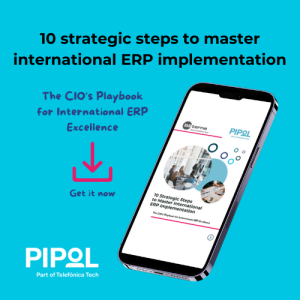Top 6 reasons for ERP Failure

Successful ERP implementation takes time to get right. From a lack of leadership to the wrong choice of partner, even large international organizations like Lidl and MillerCoors are not immune to the potential pitfalls of failure. Below we discuss 6 reasons why ERP implementation fails and what you should be aware of to avoid expensive implementation mistakes.
1. Lack of leadership and dedicated resources
Successful implementation requires commitment from everyone in the organization. One reason why global ERP projects often fail is a lack of leadership buy-in. When top management supports such projects, implementation runs much more smoothly with timely decision making and a commitment to allocating the resources when and where they’re needed.
Because failure can be hugely expensive.
Back in 2011, grocery chain store Lidl started an ERP implementation project that lasted 7 years- much longer than anticipated and indeed longer than most retail and distribution businesses can withstand. The entire project was dropped 3 years after going live at a staggering cost of €500m. There are a few reasons why this project failed to achieve its goals. For one, during the 7 years, there were constant fluctuations in the Lidl executive team. This made it more difficult to get continuous buy-in and adhere to deadlines. And naturally, the project lost momentum as time went on.
Successful ERP implementation not only needs strong leadership it also needs a high-performing, core team of experienced, cross-functional individuals. These team members need to dedicate their time to the project, and it should be their primary assignment so you must assign other resources to perform their daily tasks.
2. Inadequate planning and unrealistic timelines
As the saying goes “if you fail to plan, you are planning to fail” and nowhere is this more true than for ERP projects. If you don’t adequately plan your implementation project, you might need to re-employ some of your efforts, which can mean huge additional expenses. Success comes when management sets realistic timelines and supports the ERP team by removing any obstacles to ensure they can focus on the project and adhere to those timelines.
One organization that learned its lesson the hard way is the American mattress company Select Comfort. Back in 2015, they went live with their new ERP system. But a few weeks later they had suffered a massive $83M in lost sales. It was later reported that investors had put pressure on the ERP team to go live with the solution even though they weren’t ready.
“Timing is everything”
Another example comes from one of the world’s largest chocolate manufacturers. Back in 1999, Hershey’s tried and failed to implement a new ERP solution. The organization made some critical mistakes, one of which was rolling out the system on the same day as they cut off the old system—on Halloween, one of their busiest times of the year. Despite having most of the inventory in stock, the company couldn’t process $100 million worth of orders, resulting in a 19% drop in profit, a 12% drop in sales, and a huge loss to market credibility.
3. Ineffective change management
People often take the approach if it isn’t broken, why fix it. That’s why everyone in the organization needs to understand why things are changing and what that means to the business and their specific job roles. Change management looks at implementation from a people perspective and defines a structured process that allows you to effectively prepare, support, and assist everyone in your organization in making organizational changes.
In 2013, makeup giant Avon’s $125 million implementation project failed and more than a third of their independent sales reps in the affected area resigned. It was reported that the new system added extra work for these sales reps. Not only had Avon failed to align the new ERP software to the business processes it had also failed to invest in change management and underestimated the impact the system would have on the sales reps’ daily tasks.
By effectively managing change throughout every region and subsidiary, and not just focusing on the headquarters, people are more likely to feel ownership and accept the system when it’s rolled out. Successful implementation can be achieved by anticipating the impacts on everyone in the organization, and openly communicating and engaging with them along the way.
4. Inefficient Master Data Management
Importing legacy data into new ERP infrastructure can often cause issues. Large, long-running organizations can have millions of terabytes of data, including lots of outdated, unnecessary data. The right quality and quantity of data is vital for business decision-making, so it’s important to clean your data before proceeding with any implementation. This can shorten the duration of the project and improve overall operational efficiency.
Back in 2013, when Target, the American department store chain, was launching in Canada, they assumed this wouldn’t be an issue for them. Target would input all new data into their new ERP system so there was no legacy data to convert. However, upon launch, they quickly realized that this new data was full of errors. The new data was entered into the system by entry-level employees who lacked support and had no experience with the data. Therefore, they couldn’t recognize when incorrect data was provided by manufacturers and simply inputted the data as-is.
This costly mistake could have been avoided if Target had supported the data entry process by allocating skilled team members to supervise and assist.
5. Inadequate testing of the system
ERP implementation is complex, and failure rates are high. By rigorously testing your solution, you can help ensure the quality of your application as well as identify areas of improvement. By testing the solution’s functionality, critical processes, and overall performance, you can increase your odds of avoiding ERP failure.
In 2001, American multinational Nike spent $400 million updating their ERP and supply chain system. But the new demand-planning solution that they launched wasn’t adequately tested and the supply chain software failed. This cost Nike $100 million in lost revenue after the system advised them to order low-selling sneakers instead of high-demand ones. Nike spent 5 more years and millions of dollars more to resolve these problems.
When you’re new ERP solution goes live, there will be unexpected issues. But with quality testing, you can lessen these issues and improve your odds of success.
6. Working with the wrong partner
Regardless of the size of your organization, implementing an ERP solution is a complex task and it’s always advisable to work with an experienced partner through the entire process.
In 2014, beverage company MillerCoors hired HCL Technologies to help them combine their 7 individual ERP solutions onto a single ERP platform. However, the project faced numerous issues and the company ended up suing HCL for $100 million. These issues were blamed on inadequate planning- it was reported that the planning and architectural phases were rushed though. As it turned out, HCL did not have the right expertise for this particular project- their core competency was implementation, and not planning and architecture.
This is just one example of why you should always work with the right partner for your specific project. Experienced partners will bring to the table the right skills and knowledge helping you to accurately achieve your project goals—faster and at a lower cost.
Are you considering a new global ERP solution?
Regardless of the size of your organization, starting a new International ERP implementation project is a major undertaking. It will impact all areas of your business and requires a large amount of time, resources, and money. But these short-term issues will lead to long-term gains, and once you’re up and running you’ll enjoy higher profits, improved customer satisfaction, and business growth that will ultimately take your organization to the next level.
Get in touch with Pipol today to learn how we can support your ERP implementation project.
Download and get our 10 Steps Guide to International ERP Implementation on email now:
We wish you a safe, simple, and successful journey.





